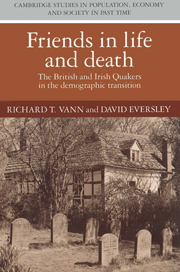Book contents
- Frontmatter
- Contents
- List of figures
- List of tables
- Preface
- Introduction
- 1 The quality of the sources
- 2 Characteristics of the sample
- 3 Marriage according to Truth
- 4 The fruitfulness of the faithful
- 5 The quality and quantity of life
- Conclusion
- Bibliography
- Index
- Cambridge Studies in Population, Economy and Society in Past Time
Introduction
Published online by Cambridge University Press: 23 September 2009
- Frontmatter
- Contents
- List of figures
- List of tables
- Preface
- Introduction
- 1 The quality of the sources
- 2 Characteristics of the sample
- 3 Marriage according to Truth
- 4 The fruitfulness of the faithful
- 5 The quality and quantity of life
- Conclusion
- Bibliography
- Index
- Cambridge Studies in Population, Economy and Society in Past Time
Summary
Why a book on the demography of the British and Irish Quakers? And what kind of book?
We have written this book as a contribution to the social history of Quakerism and to the history of British and Irish populations from the mid seventeenth to the late nineteenth centuries. The context for the former is fairly obvious, but the latter requires some elaboration. We therefore begin with our larger framework, that of the evolution of historical demography in the last twenty-five years.
For the generation which spanned World War II, the explanation of both English and Irish population growth during the century from 1750 to 1850 was fairly clear and uncomplicated, even though there was a latent contradiction between two parts of the explanation. The only evidence that scholars had to work with was estimates of the crude birth and death rates. In England, there was admittedly a rise in the birth rate, attributed to the decline of apprenticeships, greater opportunities for employment in industry or industrial by-employment, and (by some) to the operation of the Poor Laws. All these were supposed to have allowed workers to marry earlier and thus (assuming the absence of family limitation) have larger families. Despite these indications of higher fertility, there was general agreement with the conclusion of G. Talbot Griffith that “the fall in the death rate is a much more striking movement during this period than the rise in the birth rate.”
- Type
- Chapter
- Information
- Friends in Life and DeathBritish and Irish Quakers in the Demographic Transition, pp. 1 - 10Publisher: Cambridge University PressPrint publication year: 1992

